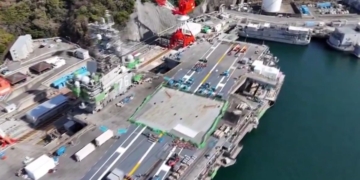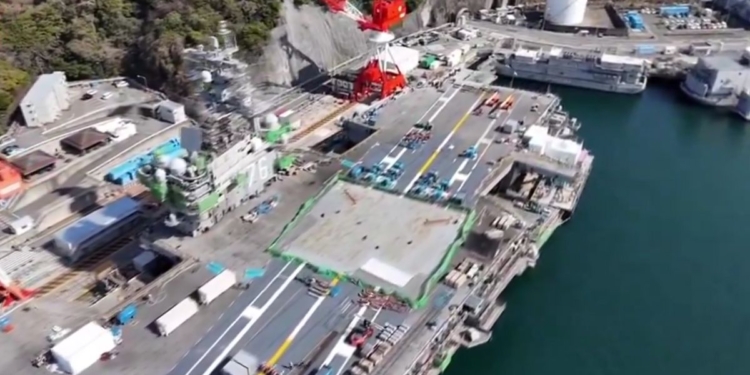A seagoing vessel or aircraft approaching a warship of the U.S. — or any nation, for that matter — must identify itself or face what could be lethal consequences.
Conventional spycraft take time to reach their target and can be immobilized before breaching a ship’s security.
But what about a drone, quickly zipping above and around a ship, gathering its spy data, and then just as quickly vanishing?
Welcome to a new military headache.
What’s more, a drone incursion may be more than a spy venture, but an attack.
While U.S. and Japanese officials are somewhat vague about the origins of the video, apparent drone photography was used to post on social media pictures of the American aircraft carrier USS Ronald Reagan when it was recently at Yokosuka Naval Base in Japan, Stars and Stripes reported.
The video of the carrier appeared on social media platform X.
The drone was reportedly put up by a Chinese citizen.
Another security scandal at Japan’s Yokosuka Naval Base.
A drone launched by a Chinese citizen (not confirmed) flew over the deck of nuclear-powered supercarrier USS Ronald Reagan at Yokosuka Naval Base. pic.twitter.com/qJmhtNQXWe
— Clash Report (@clashreport) May 8, 2024
While not assigning drone photography to the pictures of the Reagan, the Defense Ministry of Japan is pointing to drone operation for video of a docked Japanese destroyer appearing in March on a Chinese website for video sharing, according to NHK World.
Drone operation around military facilities is prohibited in Japan, NHK said. In the U S., recreational drones are prohibited near Department of Defense facilities, according to the Air Education and Training Command.
The Reagan, which has since departed the Yokosuka base for eventual arrival at Puget Sound Naval Shipyard in Bremerton, Washington, was shown in an X post on April 4 along with the USS Blue Ridge, an amphibious command ship, and some destroyers plus images of the local coastline.
The video taken directly over the carrier was posted on May 8.
The U.S. Navy said it had not concluded that the images were taken from a drone, Stars and Stripes said.
Nevertheless, the naval base and ships “have several force protection measures in place every day,” base spokesman Justin Keller told Stars and Stripes.
There was no security threat to the base or to the Reagan crew, Keller said.
But Japanese Defense Minister Kihara Minoru expressed concern about pictures of his country’s destroyer Izumo, which were posted on the Chinese web site “bilibili” in March.
Contrary to claims on X that the images were created by artificial intelligence, the Japanese defense ministry said they were authentic.
The person claiming responsibility for the Izumo photography also posted to X and made public pictures of an aircraft carrier with the same identification number — 76 — as the Reagan.
Minoru noted the ability of a drone to inflict damage and represented possible serious undermining of Japanese defense.
He said security around defense installations will be increased.
Professor Sato Heigo, a defense policy expert at Takushoku University, said drone breaches of military bases are shocking.
“How to obstruct drones that aim to gather information is becoming a major issue for other countries too,” Heigo said. “It is not very efficient to allocate human resources to detecting drones, so it would be reasonable to deal with them in a mechanical manner.”
“Security responses to incidents always change as technology progresses,” he continued. “The Self-Defense Forces need to continue to monitor changes in technological movements in detail and consider how to deal with them effectively and efficiently.”
Current Japanese drone defense includes radio and optical sensors, radio interference and shooting of nets at the drones.
This article appeared originally on The Western Journal.


























 Continue with Google
Continue with Google